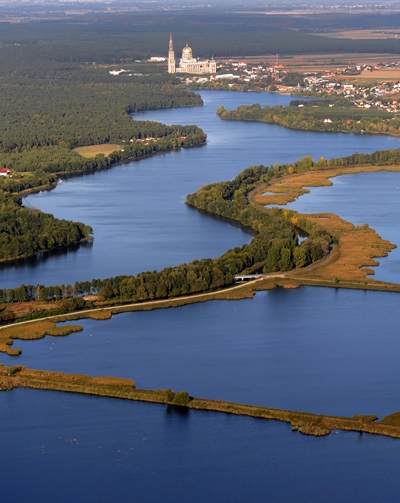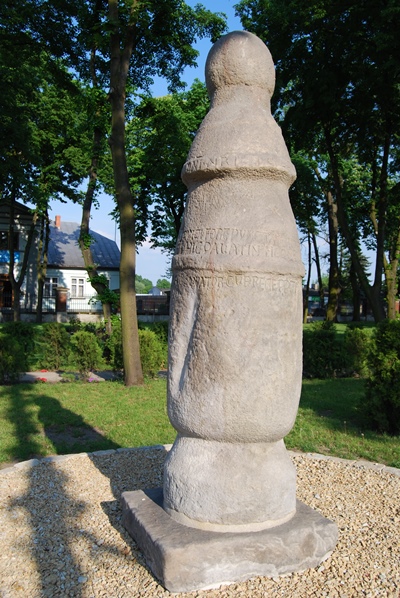 Many inhabitants of Poland associate the area of Konin with large fuel and energy industries. This often leads to the quick assumption that it is an ecologically degraded region. However, this is a misleading belief. Such assumptions disappear once we learn more about its history, monuments, and nature. Culturally, this is one of the most interesting sub-regions of Poland, known as Eastern Greater Poland. The area's low forestation is compensated by the pristine condition of its water reservoirs and diverse landscape. Passing through the vicinity of Licheń, one might even get the impression of being in Masuria. Our journey takes us along winding routes around lakes, crossing numerous waterways. We are lifted along the crests of dykes, and above us, many species of water birds glide, having found abundant food in the rich lakes.
Many inhabitants of Poland associate the area of Konin with large fuel and energy industries. This often leads to the quick assumption that it is an ecologically degraded region. However, this is a misleading belief. Such assumptions disappear once we learn more about its history, monuments, and nature. Culturally, this is one of the most interesting sub-regions of Poland, known as Eastern Greater Poland. The area's low forestation is compensated by the pristine condition of its water reservoirs and diverse landscape. Passing through the vicinity of Licheń, one might even get the impression of being in Masuria. Our journey takes us along winding routes around lakes, crossing numerous waterways. We are lifted along the crests of dykes, and above us, many species of water birds glide, having found abundant food in the rich lakes.
Kazimierz Forest, a fragment of the ancient Pyzdry-Konin Primeval Forest, with the still-functioning Camaldoli Hermitage in Bieniszew (one of only two in Poland), reveals its unique charm. Not far away, overlooking Gosławskie Lake, stands the Gothic castle of Andrzej Łaskarz, an eminent diplomat during the reign of Władysław II Jagiełło. Nearby, we can also find an octagonal St. Andrew the Apostle church, adorned with rich heraldic decorations. It is believed that this church was inspired by the St. Maurice Church in Constance (Switzerland) and stands as a magnificent example of European architectural excellence. It is no surprise that replicas of this church have been built in Miszewo Murowane in Masovia and in Oksza, near Jędrzejów in Lesser Poland. The cultural heritage of this region is not limited to its preserved monuments; it is deeply reflected in the history of this sub-region. Kazimierz Biskupi was the center of the lands owned by the bishops of Lublin, who also resided in Fürstenwalde, Lubusz, and Gorzyca. These bishops played a key role in integrating the Konin District into the histories of the Czech Republic (Prague, Stara Boleslav, and Sazwa) and Germany. The historic Konin District (until 1793) was under the strong influence of the Cistercian Abbey in Ląd by the Warta River, which had close ties with the German Abbey of Altenbergen and Cologne, the metropolis on the Rhine.

To truly understand the historical significance of this area, one must delve into the Roman and Gothic art found here. It is essential for appreciating what we see along one of the most well-known routes in Greater Poland – the Piast Route. In Pobiedziska, Waliszewo, Gniezno (cathedral), Trzemeszno, and Strzelno, we can easily find traces of the connections between these temples, monasteries, and the Konin region. For instance, the beautiful epitaphs in the Norbertine convent in Strzelno, dedicated to local provosts and priests such as Sierakowski and Jaskólski, are from Konin District. Without a deeper understanding of Greater Poland’s contribution to national culture – including its role in the establishment of the Jagiellonian University in Kraków – it is difficult to fully appreciate the region’s significance. Moreover, without a knowledge of the history of the Konin area, we lack insight into Poland's origins, its relationships with the Teutonic Order in Prussia, and its place in European history.
Learning about the history and magnificent cultural heritage of this region will certainly make it easier for us to follow Polish traces in Italy, Germany, France, Sweden, Great Britain, the Czech Republic, Austria, and many other countries. Here, we will gain the confidence that we are indeed Europeans. In this land, we can trace the historic battles with the Teutonic Order, but we can also observe the presence of people from Konin in Pomerelia (for example, at the Cistercian Abbey in Oliwa, Malbork, Skarszewy, and Sobowidz). These traces are also visible in Poland’s capitals (Kraków, Warsaw). The presence of these historical landmarks emphasizes our ancestors’ specific understanding of Europe’s cultural space: we need not look for Europe beyond our borders; we must create it in our own home. This land, Greater Poland, has always been and remains an integral part of Europe, with the Warta River and its tributaries, such as the Noteć and Prosna, reflecting a unique and individual cultural heritage. The region's fascinating castles, churches, monasteries, palaces, and historic sites are worth visiting to truly appreciate Europe’s shared cultural legacy.







